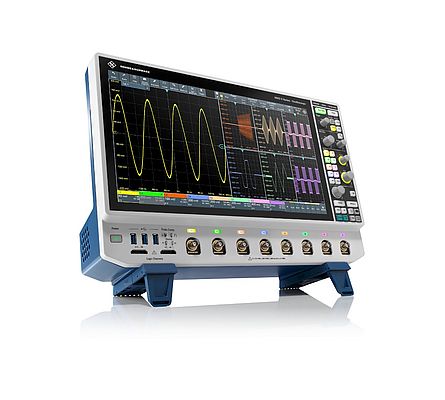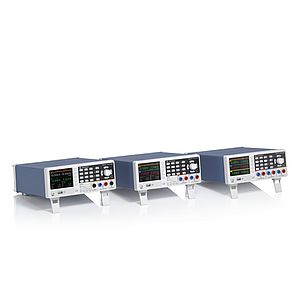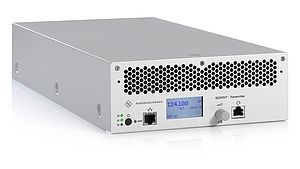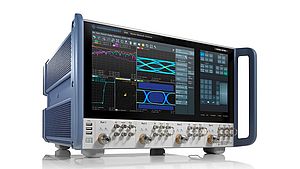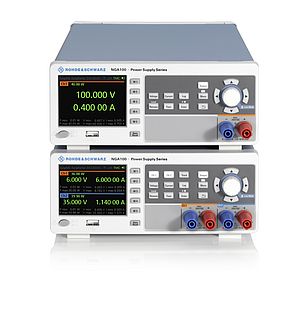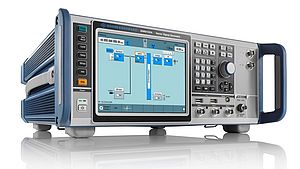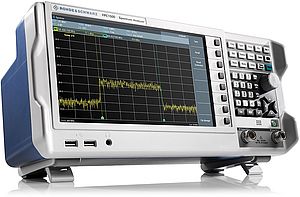The new R&S MXO 5 oscilloscopes with four or eight channels are now available from Rohde & Schwarz. The new eight-channel oscilloscopes take measurement performance to the next level, based on next-generation MXO-EP processing ASIC technology. Capturing more of a signal's activity in both the time and frequency domains than any other oscilloscope, the MXO 5 is the world's first eight-channel oscilloscope with 4.5 million samples per second and 18 million waveforms per second across multiple channels. It allows engineers to capture the finest details of signals and rare events with exceptional accuracy. It features digital triggering on all eight channels to outperform the competition in accurately isolating small signal anomalies. Its ground-breaking capability of 45,000 FFTs per second gives engineers unparalleled insight into the spectrum of signals. This is particularly useful for EMI and harmonic testing.
By capturing up to 99% of the real-time signal activity with the world's fastest acquisition capture rate, the R&S MXO 5 speeds up signal analysis while at the same time detecting rare and random events that are missed by most other oscilloscopes. These features enable engineers to debug designs more efficiently in a wide range of applications - from power conversion to automotive analysis. Power and signal integrity measurements, as well as logic and bus protocol debugging, are made easy.
Best-in-class standard memory
The R&S MXO 5 series offers a standard simultaneous acquisition memory of 500 Mpoints across all eight channels, twice as much as the competition. The large memory can be used for extensive data acquisition. In addition, a memory expansion option doubles the acquisition length to 1 Gpoints for the most demanding applications. The exceptional depth of memory is critical for a wide range of troubleshooting tasks, allowing longer recording times and maintaining accurate bandwidth information even with slower timebase settings.
First digital trigger for eight channels
As the first eight-channel oscilloscope with digital triggering, the R&S MXO 5 sets a new standard in signal analysis. The digital trigger is superior to all other oscilloscope triggers due to its remarkable sensitivity of 0.0001 div. This sensitivity enables the precise isolation of small physical layer anomalies even in the presence of large signals. No other instrument on the market can match this trigger sensitivity. Other instruments often require signal processing corrections to align the trigger events in the analogue path, which results in a slower and noisier trigger performance. The digital trigger allows engineers to take full advantage of the precision of the R&S MXO 5 by seamlessly complementing the oscilloscope's 18-bit vertical architecture.
Evolved user experience
For RF measurements in both the time and frequency domains, the R&S MXO 5 offers outstanding performance. It is the first oscilloscope to offer 45 000 FFTs (Fast Fourier Transforms) per second. This exceptional speed, combined with the ability to display four different time-independent spectra simultaneously, provides engineers with outstanding visibility into RF signals. This is unmatched in its class. These advanced capabilities are standard features of the R&S MXO 5.
An unprecedentedly large 15.6" full HD capacitive touch screen and an intuitive user interface optimise the learning curve and make the R&S MXO 5 oscilloscopes a seamless and engaging visual experience. The small footprint and world-class VESA mounting make the oscilloscopes ideal for any engineering workspace.
The MXO 5 is available in four- and eight-channel models with bandwidths of 100 MHz, 200 MHz, 350 MHz, 500 MHz, 1 GHz and 2 GHz. For users with more demanding application requirements, a range of upgrade options are available. These include 16 digital channels with a mixed-signal oscilloscope (MSO) option, an integrated dual-channel 100 MHz arbitrary waveform generator, protocol decode and trigger options for industry-standard buses, and a frequency response analyser to extend the instrument's capabilities.


